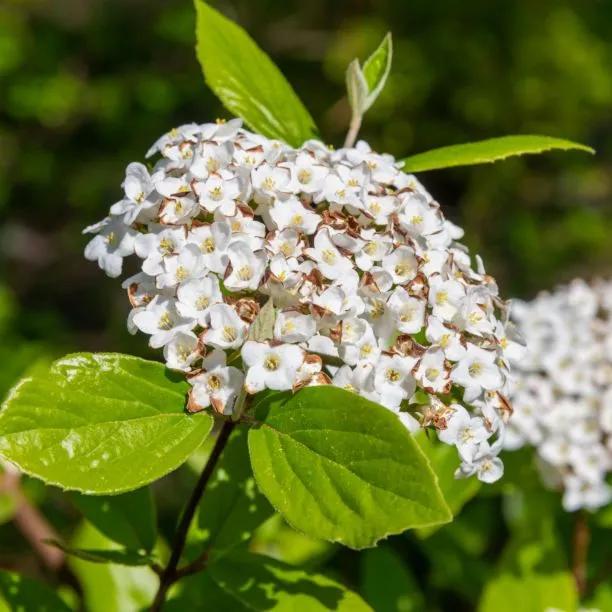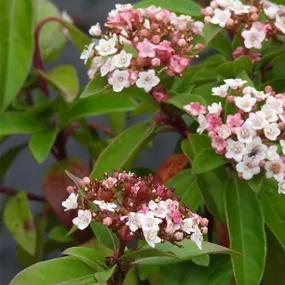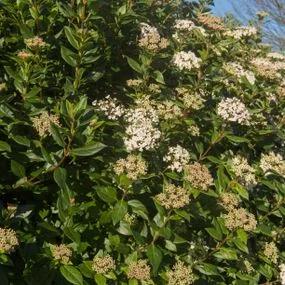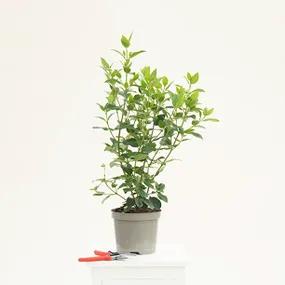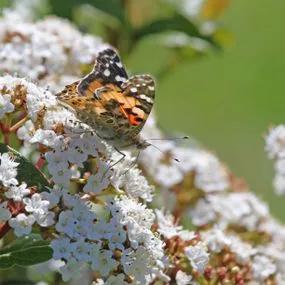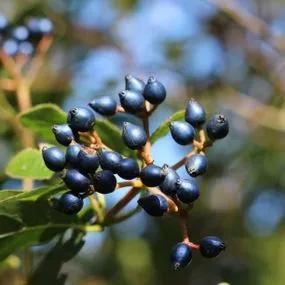Viburnum Eve Price Hedge Plants
Honest Delivery PricesViburnum tinus 'Eve Price'
- Evergreen. Suitable for hedging.
- Flowers October-April
- Shade tolerant. Any soil.
- RHS Award of Garden Merit
- RHS Plants for Pollinators
- Max. Height 3m
- Year round delivery.
Recommended extras
Description
Eve Price Viburnum Hedging
Also known as Laurustinus, Viburnum tinus 'Eve Price', is a steady growing, bushy, evergreen shrub that flowers in winter and makes a pretty hedge plant. Ideal for a small garden and suitable for any fertile soil. In ideal conditions, it will eventually make a hedge or specimen shrub of up to 3 metres high, although it may struggle to get over 2 metres if your site is shady.
See our selection of evergreen hedging plants or see our full range of hedging.
Viburnum tinus Eve Price plants are only delivered pot-grown, year round.
Choosing a size:
All our hedge plants are measured by their height in centimetres above the ground (the pots aren't measured).
Spacing a Viburnum tinus Eve Price hedge:
Plant Viburnum tinus Eve Price hedging at 3 plants per metre
General description of Viburnum tinus Eve Price plants:
Viburnum tinus Eve Price is also known as Laurustinus. It has lush, glossy evergreen leaves that clip very well and give a perfect backdrop to the neat, flattened clusters of tiny carmine coloured flower buds that form in late summer. The bush begins to flower in October and continues through to April. The domed white flower heads bloom in waves, mingling with the delicate pink unopened buds. The berries that follow are deep blue-purple and attractive to wildlife.
It is an excellent plant for a problem areas, as it is good in shade, thrives by the sea, stands wind well and is happy in almost any soil. It is a good choice for the low, shrubby element in a windbreak, planted alongside rows of taller trees. It is also great for planting directly beneath deciduous trees.
Viburnum tinus Eve Price is unusual in that, unless the winter is very harsh, it will often still be bearing the previous year's berries when the new buds are beginning to flower. This adds to your plant's ornamental value and it is also good news for hungry birds. It is fully hardy throughout Britain, although tough winters can suppress the flowers.
History & uses of Viburnum Eve Price:
The name Laurustinus, comes from the similarity of its leaves to those of the bay laurel, which is in the genus Laurus. However, Viburnums are not related to laurels, but are in the Adoxaceae family along with the very different looking genus Sambucus, elderflower.
Tinus is Latin for 'tenth', which refers to the shrub's habit of flowering in October, the tenth month.
Viburnum tinus originates from the Mediterranean and in particular the islands off the coast of North West Africa, which can experience extreme temperature swings and tempestuous weather conditions - not so different from Britain!
Viburnum tinus has been cultivated in England for about 400 years and Eve Price was named after the lady of the manor at Wakehurst Place, West Sussex, where it was bred in the first half of the 20th century.
Today, Wakehurst is owned by the National Trust, and managed by Kew Royal Botanic Gardens.
Planting Instructions
Growing Viburnum tinus Eve Price plants:
Viburnum tinus Eve Price will grow well in almost any soil conditions. It is fine on chalk, damp sites and on the coast. Mature plants are drought resistant, but you must water new plants in dry weather for several years to give them a chance to develop a deep root system.
Eve Price is hardy across Britain, but we don't recommend it for frost pockets or exposed sited in the North and Scotland. It will grow there, but you probably won't get any flowers in winter.
Prepare your site before planting:
It is good to dig over the area where you plant a hedge several months in advance, especially if the soil is poor. Destroy the weeds first: nettles, brambles and ground elder are tough and weed-killer is the best way to remove them. Then dig the soil over; remove rocks, roots and other rubbish. Mix in well rotted compost or manure down to the depth of about 2 spades. If your soil is rich, you don't have to dig it over, but killing all the weeds is still necessary.
Watch our video on how to plant a garden hedge for full details.
Remember to water establishing plants during dry weather for at least a year after planting.
Hedge Planting Accessories:
Prepare your site for planting by killing the weeds and grass
You can buy a hedge planting pack with sheets of mulch fabric and pegs to hold it down.
If you are planting in an area with rabbit and/or deer, you will need to use a plastic spiral guard for each plant, supported by a bamboo cane.
If your soil quality is poor, we recommend using mycorrhizal "friendly fungi" on the roots of new trees and shrubs.
After you have planted your Viburnum tinus Eve Price hedge, the most important thing to do is water it in dry weather. You will also need to weed around the plants. Watering should be thorough, so the ground is soaked. Let the soil almost dry out before watering again. Watering & weeding will be necessary for at least a year after planting.
Like all evergreen plants, Viburnum tinus Eve Price is active and needs moisture in the ground throughout the year. This means that your establishing plants need to be watered in the winter when they are planted, if the weather is dry.
Trimming Formal hedge plants: Viburnum tinus Eve Price is a relatively slow growing plant and is naturally bushy, so it doesn't need any clipping at all in its first year. Starting a year after planting, clip it lightly once each winter until it is mature.
When it is fully grown, you can clip it at anytime. A good time to clip Viburnum tinus Eve Price hedges is after it finishes flowering in spring.
Special notes on caring for Viburnum tinus Eve Price hedges:
Viburnum tinus Eve Price is a very tough hedge plant that shouldn't need special attention once it has established. If you didn't use a mulch fabric, it is beneficial to mulch around the base of the hedge each year with well rotted manure or compost.
Hygiene & Diseases:
Dead, damaged or diseased wood can be pruned off as soon as it appears.
Disinfect your pruning tools between every cut if there is any sign of disease.
Burn or dispose of any diseased material, do not compost it.

